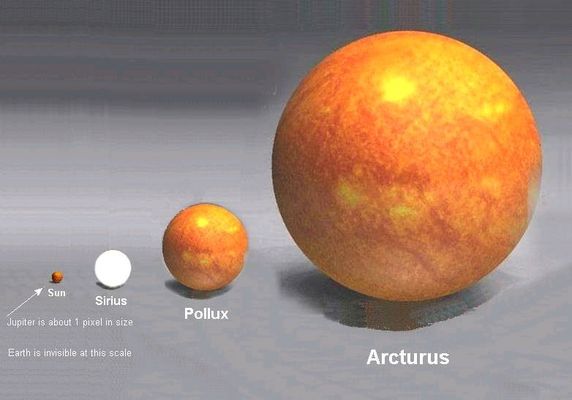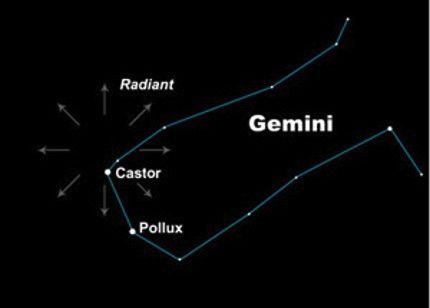
On April 1, 2020, you’ll find the moon at or near its half-lit first quarter phase and in the vicinity of Castor and Pollux, the two brightest stars in the constellation Gemini the Twins. From much of Earth, the three sky objects will be in an interesting alignment on the sky’s dome … so that the Gemini “twins” temporarily become a set of triplets.
And there’s another bright star on the other side of the moon on April 1. It’s Procyon, the brightest in the constellation Canis Minor the Lesser Dog. Procyon would be hard to pick out without the help of tonight’s moon, or a good constellation chart. On the other hand, Castor and Pollux are extremely noticeable in the night sky. No other two such bright stars appear so close together.
Regardless of the seeming connection between these two stars, Castor and Pollux aren’t close together in space. They just happen to reside along the same line of sight from Earth.
Both Castor and Pollux are bright stars, and they’ve been known as Twins for centuries at least. But they don’t really look alike. Pollux is golden in color, and Castor is pure white. If you have binoculars, they’ll help you to more easily distinguish the color contrast between Castor and Pollux.
Also, Castor and Pollux are different kinds of stars. Castor is a hot, white-colored star that is well known for being a multiple system. It consists of three pairs of binary stars, that is, six stars bound together in an intricate gravitational dance. Pollux is a cool and bloated orange-colored star, said to be the closest giant star to Earth. A massive star like our sun swells up into a giant in its old age. But astronomers assure us that our sun won’t become a gain for another 5 billion years or so.
On March 31, 2020, the moon crosses the ecliptic – Earth’s orbital plane and the annual pathway of the sun across our sky – at its ascending node. That happened at 16:51 UTC. Then less than one day later, the moon reaches its first quarter phase on April 1, at 10:21 UTC.
The moon will remain north of the ecliptic (Earth’s orbital plane) until the moon crosses its descending node on April 13, 2020, at 2:58 UTC. Then the moon will stay south of the ecliptic until it crosses the ecliptic on April 27, at 11:52 UTC.
The sun, on the other hand, passes in front of Gemini for one month each year, from about June 21 to July 20.

You can see the comparative size of the star Pollux and our sun in this image, as well as some other stars. Pollux is a giant star by virtue of its age. Many stars – including our sun – will swell to the giant stage as they age.
In many cultures, Castor and Pollux were seen as twin stars, usually as heroes. Many old sky myths invoke the idea of twins to explain their proximity on the sky’s dome.
EarthSky astronomy kits are perfect for beginners. Order today from the EarthSky store

If you have a dark sky, notice that 2 nearly parallel streams of stars extend from Castor and Pollux. These stars likely reinforced the idea of twins, in various cultures around the world. Every December, the Geminid meteor shower radiates from near star Castor in Gemini.
In Greek and Roman mythology, Castor and Pollux were the twin sons of Jupiter and Leda and brothers of Helen of Troy. They sailed with Jason as two of his Argonauts.
Pollux, represented by the brighter star, was immortal, but his brother Castor was not. When Castor was killed in a fight, Jupiter wanted the two to remain together, so he decreed that they each should spend some time in the underworld and some time in the heavens. This is a fanciful way of explaining why the constellation is above the horizon for part of each day and below the horizon for the rest. Castor and Pollux are sometimes said to represent brotherly love.
Meanwhile, in China, these two stars were associated with water, as part of constellations representing rivers. They were sometimes also seen as the complementary elements of yin and yang.
Because Gemini is a constellation of the zodiac, the sun passes in front of this constellation for about a month each year, from about June 21 to July 20.
Bottom line: The moon is near the stars Castor and Pollux in the constellation Gemini the Twins on April 1, 2020. These stars represent twins in many cultures.
Enjoying EarthSky so far? Sign up for our free daily newsletter today!
Donate: Your support means the world to us
Source:
https://earthsky.org/tonight/are-geminis-castor-and-pollux-whales
